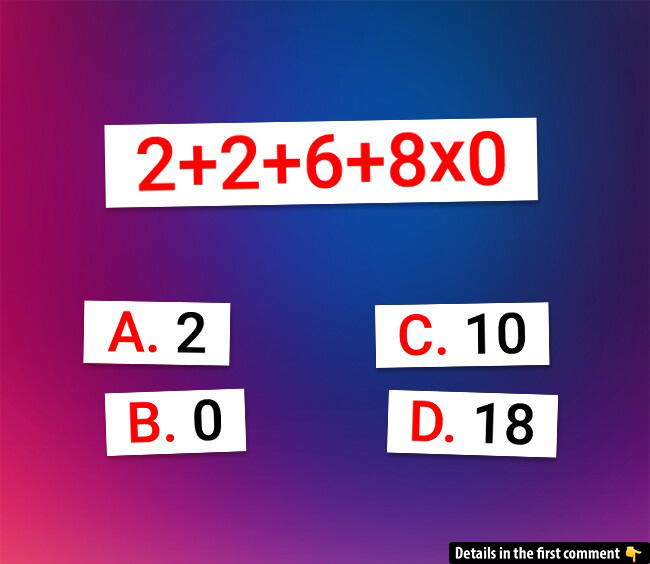Ever looked at a math problem and thought, “Easy, I’ve got this”? Only to realize later you were completely off? That’s the magic of puzzles like this—they look straightforward, but if you overlook just one tiny detail, you’ll fall into a classic trap. This one’s all about how well you remember the order of operations.
So here’s your challenge:
2 + 2 + 6 + 8 × 0 = ?
You’ve got four options:
A. 2
B. 0
C. 10
D. 18
Got your answer? Keep reading to find out if you nailed it—or fell for the trick.

Why Most People Miss the Right Answer
When you first glance at this equation, your brain wants to go left to right and add everything. And that’s exactly why most people end up choosing 0 or 18. It’s easy to overlook that one part that changes everything—the multiplication.
This puzzle isn’t about complicated math. It’s about knowing the rules, specifically the order of operations. If you remember PEMDAS (Parentheses, Exponents, Multiplication, Division, Addition, Subtraction), you’re already ahead of the game.
Let’s Solve It Together, Step-by-Step
Let’s walk through the math carefully and apply PEMDAS.
Video: Treat your brain to a moment of lighthearted fun and relaxation!
Step 1: Look for Multiplication First
In the expression 2 + 2 + 6 + 8 × 0, the only multiplication is 8 × 0. So before you do any addition, solve that:
8 × 0 = 0
That leaves us with:
2 + 2 + 6 + 0
Step 2: Add From Left to Right
Now that multiplication is out of the way, go ahead and add the rest:
2 + 2 = 4
4 + 6 = 10
10 + 0 = 10
Step 3: Final Answer
And there you go—the correct answer is C: 10
Did you get it right? Or did that sneaky zero trip you up?

The Real Lesson Behind This Puzzle
What makes puzzles like this so great isn’t just that they’re fun—it’s that they force you to slow down and think clearly. In a world that’s constantly rushing us, a little logic puzzle like this is the perfect brain break.
It also helps sharpen your skills without you even realizing it. When you train your brain to focus and follow steps, that mindset starts to carry over into daily life—from budgeting to planning your schedule to making better decisions in stressful moments.
The Power of PEMDAS: Why It Matters So Much
Let’s break down PEMDAS one more time, because it’s the star of the show here:
- P – Parentheses first
- E – Exponents (powers and roots)
- MD – Multiplication and Division (left to right)
- AS – Addition and Subtraction (left to right)
The key here? Multiplication comes before addition. So anytime you see both in an equation, solve the multiplication first. Always.
This rule helps keep math consistent and makes sure everyone gets the same answer, no matter where they start. Ignore it, and you’re in trouble.
Why We Love Puzzles Like This One
Honestly, we need more brain teasers like this in our lives. They’re short, challenging, and just the right kind of frustrating. Plus, they’re great for:
- Improving concentration
- Boosting memory
- Sharpening critical thinking
- Adding a little fun to your day
And let’s be real—who doesn’t love that “Aha!” moment when you finally figure it out?
Challenge Your Friends: Can They Solve It Too?
Video: Find The Missing Number – Hard Math Puzzle || Maths Puzzle
Now that you know how it works, share the puzzle with your friends and see how they do. It’s a great conversation starter—and it’s hilarious to watch confident people second-guess themselves when the answer isn’t what they expected.
Better yet, make it a game. See who can solve it in under 30 seconds without using a calculator. Bragging rights guaranteed.
Conclusion: It’s Not Just a Puzzle—It’s a Brain Booster
So, what did we learn from this sneaky little math problem? Simple: never underestimate the power of the basics. Following the order of operations is everything when it comes to solving math correctly.
Whether you nailed it on your first try or needed a second look, give yourself some credit for trying. Math puzzles like this are more than just numbers—they’re opportunities to sharpen your mind and have a little fun along the way.
So the next time someone says math is boring, hit them with a puzzle like this and watch their face light up. And remember—next time you see 8 × 0, don’t let it fool you.


